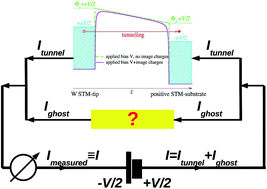Concurrent conductance and transition voltage spectroscopy study of scanning tunneling microscopy vacuum junctions. Does it unravel new physics?†‡
Abstract
We show that the conductance (G) and transition voltage (Vt) spectroscopy data for standard vacuum nanogaps reported in the preceding paper by Sotthewes et al. cannot be understood within the framework of the existing theories/models, whatever realistic effects are incorporated. However, if we include an additional (“ghost”) current, the trends of the dependencies of G and Vt on the nanogap size, d, can be explained. The ghost current is very small. Therefore, effects related to the ghost current can only be revealed at a larger d, where the ghost current becomes comparable to or overcomes the tunneling current. Although we are not able to unravel the origin of this ghost contribution, we can and do refer to experimental G- and Vt-data reported for molecular junctions, which exhibit similarities to the presently considered vacuum nanojunctions. Analyzing the notable difficulties related to the regime assigned as transport via hopping, we speculate that a ghost contribution may also exist in molecular junctions.


 Please wait while we load your content...
Please wait while we load your content...